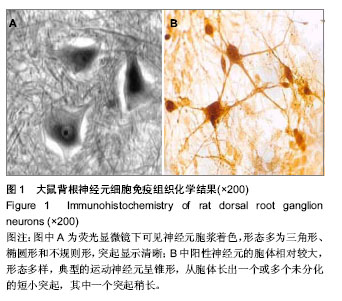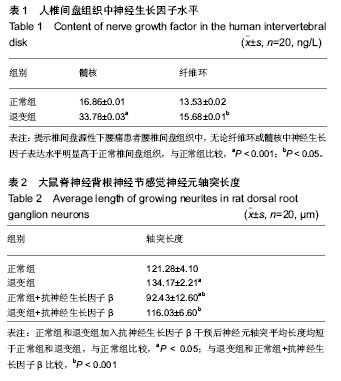| [1] Crock HV. Internal disc disruption: A challenge to disc prolapse fifty years on.Spine.l986;1(6):650-653.[2] Milette PC,Melanson D.Lumbar fiscography (letter).Radiology. 1987;163(19): 828-829.[3] Freemont AJ,Peacock TE,Goupille P, et al.Nerve ingrowth into diseased intervertebral disc in chronic back Pain.Lancet. 1997;350(9072):178-181.[4] 于一凡,谭晓琳,孙晋民.神经生长因子与周围神经病变相关性研究进展[J].中国现代医药杂志,2009,11(11):128-129.[5] 郭向飞,倪家骧.神经生长因子在椎间盘源性疼痛中的作用机制研究进展[J].颈腰痛杂志,2010,31(6):457-459.[6] 陈世新,丁茂超,胡斯旺,等.内源性神经生长因子在大鼠炎性痛中的作用及其机制[J].温州医学院学报,2011,41(2):129-131.[7] Pande KC, Khurjekar K, Kanikdaley V. Correlation of low backpain to a high-intensity zone of the lumbar disc in Indian patients. Orthop Surg (Hong Kong).2009;17(2):190-193.[8] 韩松,姜宏. 椎间盘源性下腰痛的研究进展[J].中国中医骨伤科杂志,2011,19(5):69-70.[9] Thompson KJ, Dagher AP, Eckel TS, et al. Modic changes on MR images as studied with provocative diskography: clinical relevance- a retrospective study of 2457 disks. Radiology. 2009;250(3):849-855.[10] Wasan AD, Kaptchuk TJ, Davar G, et al. The association between psychopathology and placebo analgesia in patients with discogenic low back pain. Pain Med.2006;7(3):217-228.[11] Carragee EJ, Alamin TF, Miller JL, et al. Discographic, MRI and psychosocial determinants of low back pain disability and remission:a prospective study in subjects with benign persistent back pain. Spine J.2005;5(1):24-35.[12] 郭团茂,陈忠宁,王忠贵.椎间盘源性下腰痛的组织病理学变化[J].中国组织工程研究与临床康复,2011,15(39):7366-7370[13] Gonlnoue G,Ohtori S,Aoki Y.Exposure of the nucleus pulposus to the outside of the anulus fibrosus induces nerve injury and regeneration of the afferent fibers innervating the lumbar intervertebral discs in rats.Spine.2006;31(13):1433- 1438.[14] Herkowitz HN,Gaffin SR,Balderston RA,et al.Roth man Sime on the spine.4th ed.Beijing:Science Press.2001:750.[15] 王日成.椎间盘源性下腰痛研究进展[J].中国现代医药杂志,2010,12(6):121-122.[16] 唐福兴,梁博伟,李宁宁,等.椎间盘退变程度与盘源性腰痛手术疗效的关系[J].广东医学,2013,34(7):1084-1086. [17] 王永刚,王栓科,周海宇.椎间盘源性腰痛的相关基础研究进展[J]. 现代生物医学进展,2012,12(30):5974-5977.[18] 王刚,陈志维,关宏刚,等.应用椎间盘造影判断腰椎间盘突出症腰痛的来源[J].中国矫形外科杂志,2011,19(1):15-19. [19] 李杨,杜勇,杨汉丰,等. MRI对腰椎间盘源性疼痛的诊断价值研究[J].医学影像学杂志,2011,21(1):103-106. [20] 江正,尹宗生.椎间盘源性腰痛的病理生理学机制及组织工程学技术[J].中国组织工程研究与临床康复,2010,14(20): 3736- 3739.[21] 袁慧书,庞超楠,刘晓光,等. CT引导下椎间盘造影对椎间盘源性腰痛的诊断价值[J].中国脊柱脊髓杂志,2009,19(6):412-415. [22] 李兵.椎间盘造影在手术治疗盘源性腰痛中的应用[J].微创医学, 2008,3(6):598-600.[23] 邹健,雷刚刚,吴庆能,等.椎间盘源性下腰痛与椎间盘内神经侵润生长的关系[J].实用临床医学,2008,9(6):24-26. [24] 向志军,钟生才.椎间盘源性下腰痛的最新认识[J].亚太传统医药, 2007,3(11):65-68. [25] 卓祥龙,李兵.盘源性腰痛的研究现状[J].广西医学,2007, 29(10): 1553-1555.[26] 陈兴灿,刘乃芳,李晓红,等. CT腰椎间盘造影术对椎间盘源性下腰痛的诊断价值[J].浙江医学,2007,29(7):658-660. [27] 许彪,李绪松,魏琪,等.盘源性腰痛相关问题的探讨[J]. 检验医学与临床,2007,4(5):394-395.[28] 刘林,李鑫鑫.椎间盘源性腰痛的诊断与治疗[J]. 医学综述,2007, 13(12):928-930.[29] 石作为,姚猛,王岩松,等.间盘源性下腰痛发生机制的探讨[J]. 中国疼痛医学杂志,2007,13(1):32-35. [30] 张德仁,熊东林,肖礼祖,等.选择性脊神经根阻滞治疗盘源性坐骨神经痛[J].实用疼痛学杂志,2006,2(4):199-202. [31] 周毅力,宋文阁,刘甬民,等.间盘源性腰痛的诊断与微创治疗[J]. 实用疼痛学杂志,2006,2(1):33-39. [32] 石作为,姚猛,王岩松,等.间盘源性下腰痛发生的神经解剖学基础[J].中国临床康复,2005,9(45):88-89. [33] 邱红明,孙鲁,李静,等.间盘源性下腰痛的诊断与辨证治疗[J].山东中医杂志,2005,24(9):536-537. [34] 王扬生,陈其昕.椎间盘源性下腰痛[J].颈腰痛杂志, 2003,24(5): 536-537. [35] 彭宝淦,侯树勋.交感神经在腰椎间盘的分布和盘源性下腰痛的神经传导通路[J].颈腰痛杂志,2001,22(3):247-248. [36] 彭宝淦,王拥军.国外对盘源性腰痛炎症机理的研究进展[J].中医正骨,1998,10(3):37-38.[37] 雷刚刚,吴庆能.椎间盘源性下腰痛与椎间盘内神经侵润生长的关系[J].实用临床医学, 2008, 9(6):24-25. [38] 张一鸣,张沂,唐萌芽.补肾活血中药薰蒸治疗盘源性下腰痛疗效观察[J].中医正骨,2013,25(5): 35-36. [39] 邹聪,何云武,陈金生,等. X线引导下双极射频热凝治疗盘源性腰痛32例[J].中南医学科学杂志,2013,41(1): 31-34. [40] 黄雷,李军汉.电针、推拿结合牵引治疗盘源性下腰痛疗效观察[J].颈腰痛杂志,2011,32(3): 237-238. [41] 黄乔东,魏迨桂,赵国栋,等.椎间盘内电热疗法治疗盘源性腰痛临床观察[J]. 南方医科大学学报,2010,30(10): 2406-2407,2410. [42] 王明政,李汝秀,郑瑞启.臭氧在椎间盘源性腰痛诊治中的应用[J]. 骨科,2010,1(2): 95-96 [43] 陈立,张秀玲,兰秀芳.推拿配合躯干肌功能锻炼治疗慢性盘源性腰痛的临床分析[J].中医正骨,2011,23(3): 9-12. [44] 张强,刘萍.水冷式双极射频纤维环成形术联合祛痹止痛膏治疗盘源性腰痛临床研究[J].工企医刊,2011,24(2): 64-66. [45] 闫京奎,刘智鹏,赵家瑜,等.射频消融微创治疗椎间盘源性下腰痛的疗效观察[J].实用骨科杂志,2010,16(9): 680-681. [46] 魏迨桂,黄乔东,赵国栋,等.两种微创治疗方法在盘源性腰痛治疗中的应用[J].临床医学工程,2010,17(10): 8-10.[47] 黄家俊,罗华.神经生长因子促进中枢神经系统损伤后神经再生的作用机制[J].医学综述, 2008,14(3):330-331.[48] Thompson KJ, Dagher AP, Eckel TS, et al. Modic changes on MR images as studied with provocative diskography: clinical relevancea retrospective study of 2457 disks. Radiology. 2009;250(3):849-855.[49] Al-Shawi R, Hafner A, Olsen J, et al.Neurotoxic and neurotrophic roles of proNGF and the receptor sortilin in the adult and ageing nervous system.Eur Neurosci. 2008;27: 2103-2114.[50] Aoki Y,Takahashi Y,Ohtori S. Distribution and immunocyto chemical charac- terization of dorsal root ganglion neurons innervating the lumbar interwerte-bral disc in rats:a review. Life Sci.2004;74(21):2627-2642.[51] Ribatti D, Nico B, Perra MT, et al.Correlation between NGF TrkA and microvascular density in human Pterygium. Int J Exp Pathol. 2009;90(6):615-620.[52] Peters EM, Raap U, Welker P, et al. Neurotrophins act as neuroendocrine regulators of skin homeostasis in health and disease.Horm Metab Res.2007;39(2):110-124.[53] Sugiura A, Ohtori S, Yamashita M, et al. Existence of nerve growth factor receptors, tyrosine kinase a and p75 neurotrophin receptors in intervertebral discs and on dorsal root ganglion neurons innervating intervertebral discs in rats. Spine.2008;33(19):2047- 2051.[54] Garcia M, Forster V, Hicks D, et al. In vivo expression of neurotrophins and neurotrophin receptors is conserved in adult porcine retina in vitro. Invest Ophthalmol Vis Sci.2003; 44(10):4532[55] Pande KC, Khurjekar K, Kanikdaley V. Correlation of low back pain to a highintensity zone of the lumbar disc in Indian patients. Orthop Surg (Hong Kong).2009;17(2):190-193. [56] 王丽华,姜虹.不同剂量神经生长因子对神经源性疼痛大鼠脊髓 Fos蛋白的影响[J].中国组织工程研究与临床康复, 2009, 13(50): 9866-9869.[57] 王德胜,黄烈天,扬兴桃.鼠神经生长因子(mNGF)局部注射治疗周围神经缺损伤的临床研究[J].齐齐哈尔医学院学报, 2011, 32(3):369[58] 彭形.神经生长因子生物学效应的研究进展[J].检验医学与临床, 2009,6(3):203-204.[59] 路露,陈美婉,罗焕敏.神经营养因子受体的研究进展[J].中国老年医学杂志,2010,30:126-131. [60] Ashton IK, Roberts S, Jaffray DC, et al. Neuropeptides in the human intervertebral disc. J Orthop Res.1994;12(2):186-192.[61] Peng B, Wlu W, Hou S, et al.The Pathogenesis of Discogenic Low Back Pain.J Bone Joint Surg Br.2005; 87(1):62-67.[62] Aoki Y,Ohtori S,Takahashi K, et al. In nervation of the lumbar intervertebral disc by nerve growth factor dependent neurons related to inflammatory pain. Spine.2004; 29(10):1077-1081.[63] Yamaguchi J, Aihara M, Kobayashi Y, et al. Quantitative analysis of nerve growth factor (NGF) in the atopic dermatitis and psoriasis horny layer and effect of treatment on NGF in atopic dermatitis . J Dermatol Sci. 2009,53:48-54.[64] Purmessur D,Freemont AJ,Hoyland JA. Expression and regulation of neurotrophins in the nondegenerate and degenerate human interverteb-ral disc.Arthritis Res Ther. 2008; 10(4):99-100.[65] Richardson SM,Doyle P,Minogue BM, et al.Increased expression of matrix metalloproteinase-10,nerve growth factor and substance P in the painful degenerate intervertebral disc.Arthritis Rea Ther.2009; 11(4):126-127.[66] 周昊嵬,侯树勋,商卫林.椎间盘源性下腰痛与椎间盘内神经生长[J].国外医学:骨科学分册,2011,26(6):339-341.[67] Lee S,Moon CS,Sul D, et al. Comparison of growth factor and cytokine expression in patients with degenerated disc disease and herniated nucleus pulposus.Clin Biochem.2009; 42(15): 1504-1511.[68] Lei D, Rege A, Koti M, et al. Painful disc lesion: can modern biplanar magnetic resonance imaging replace discography. Spinal Disord Tech. 2008,21(6):430-435.[69] 何传正,唐海燕,吴发庆.椎间盘源性下腰痛的发生机制与治疗现状[J].吉林医学,2010,31(18):2909-2910. |


.jpg)
.jpg)